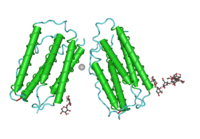
Photo from wikipedia
ABSTRACT Type I IFNs are considered to be the core IFN species in vertebrates because of their predominant antiviral effects. But, a puzzling question remains to be answered, as to… Click to show full abstract
ABSTRACT Type I IFNs are considered to be the core IFN species in vertebrates because of their predominant antiviral effects. But, a puzzling question remains to be answered, as to how intronless type I IFN genes in amniotes might have evolved from intron‐containing type I IFN genes in fish and amphibians. In this study, intronless and intron‐containing type I IFNs were found in the amphibian model, Xenopus tropicalis, with a total of sixteen and five genes, respectively. The intronless IFNs can be divided into three subgroups, and the intron‐containing ones into two subgroups, implying that a retroposition event might have occurred in amphibians, resulting in the generation of intronless type I IFN genes. Two models were tentatively proposed to explain the evolution of type I IFNs in vertebrates: in model A, fish should possess the most primitive multi‐exon‐containing type I IFNs, and intronless type I IFN genes in amphibians are the ancestor of modern intronless type I IFNs in amniotes; in model B, intronless type I IFN genes in X. tropicalis may just represent an independent bifurcation in this species or probably in amphibians, and intronless type I IFN genes in amniotes may have arisen from another retroposition event occurred in a transition period even when reptiles were diverged from amphibians. It is considered that the model B can reflect the current knowledge on the occurrence of intronless and intron‐containing type I IFN genes in vertebrate lineages. This study thus contributes to a better understanding of the origin and evolution of type I IFNs in vertebrates, and of the occurrence of intronless I IFNs in higher vertebrates. Graphical abstract Figure. No Caption available. HighlightsIntronless and intron‐containing type I IFN genes coexist in Xenopus tropicalis.Intronless and intron‐containing IFNs phylogenetically divide into three and two subgroups respectively.Different gene expression patterns were observed among subgroups of IFNs.Retroposition might have occurred in amphibians with the generation of IFNi genes.Models were proposed to explain the evolution of type I IFNs in vertebrates.